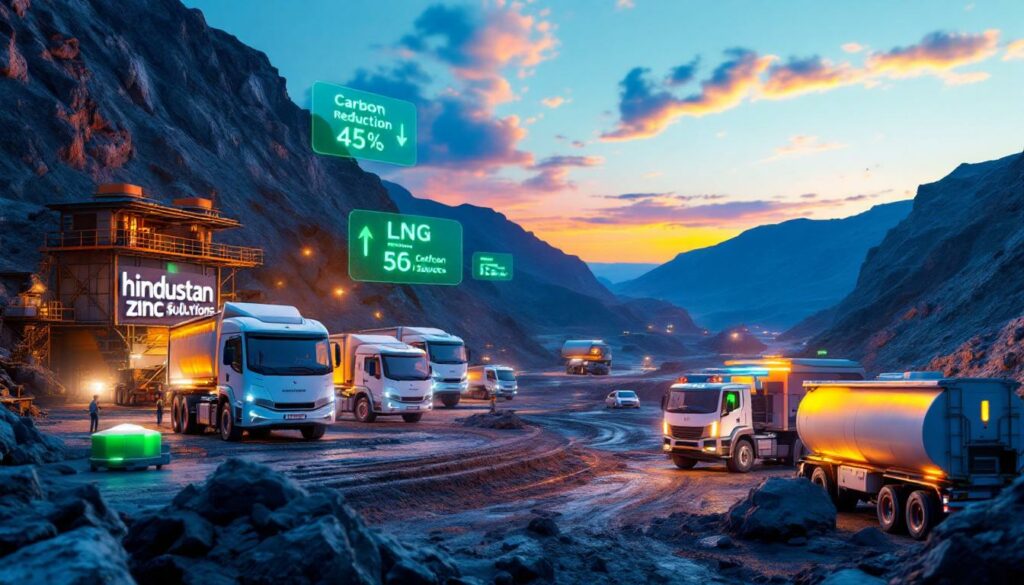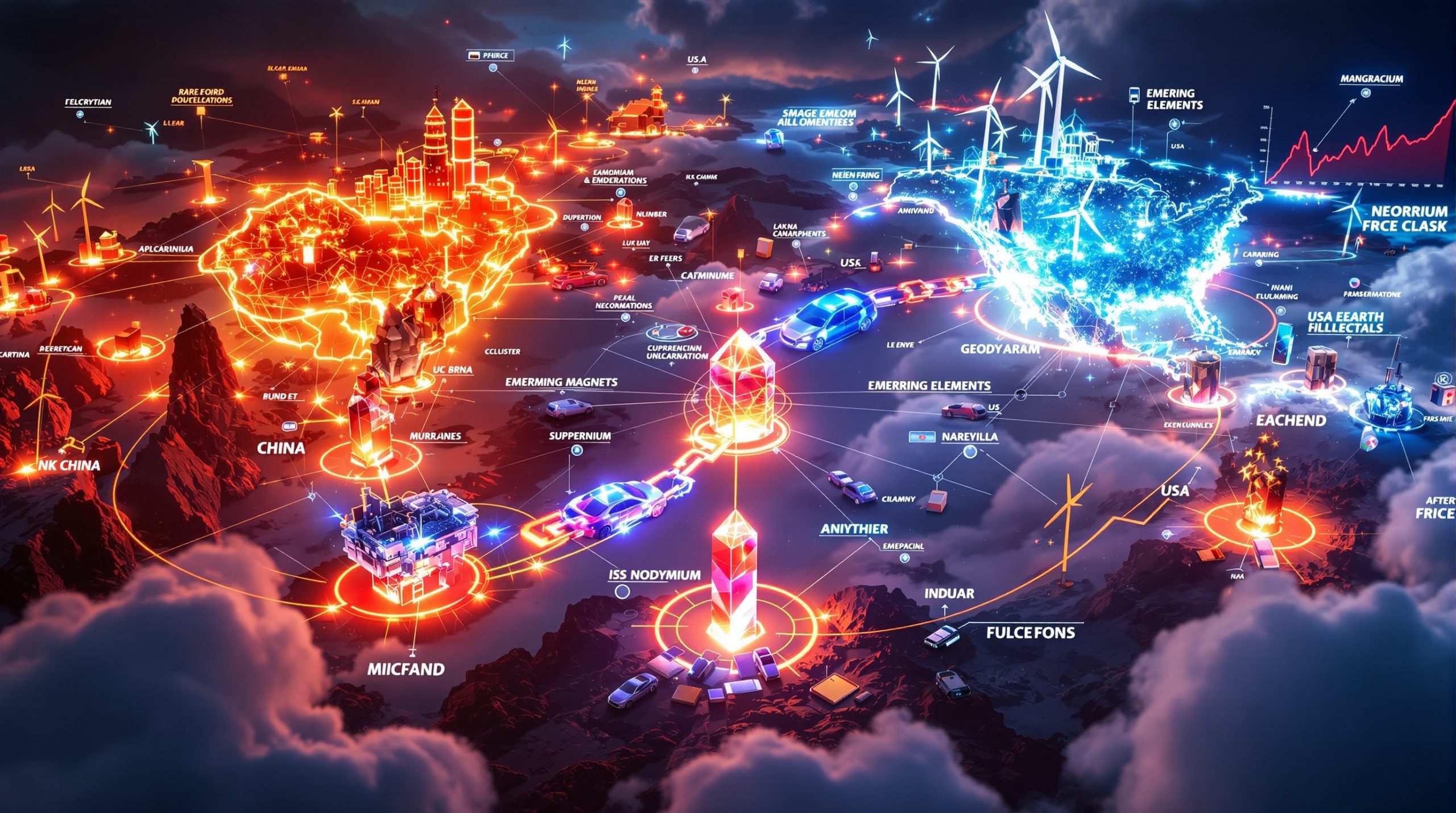India's Green Revolution: GreenLine's $46 Million Investment in Electric Trucks for Mining
In a significant move toward sustainable mining logistics, GreenLine Mobility Solutions has announced a major investment in electric truck fleets for Hindustan Zinc operations. This strategic initiative represents a pivotal step in India's transition toward greener mining operations and demonstrates the mining industry's growing commitment to environmental sustainability.
What is GreenLine Mobility Solutions Investing in Hindustan Zinc?
GreenLine Mobility Solutions has committed 4 billion rupees (approximately $45.7 million) to expand its electric truck supply fleet specifically for Hindustan Zinc operations. This substantial investment aims to replace conventional diesel vehicles with zero-emission alternatives, marking a significant advancement in sustainable mining logistics across India.
The investment forms part of a broader commitment made by GreenLine in April 2025, when the company pledged $275 million to accelerate the mining decarbonisation of heavy trucks in industrial operations. This latest funding represents a concrete step toward fulfilling that promise, with a clear focus on transforming mining transportation.
Investment Breakdown and Implementation Timeline
The 4 billion rupee investment will primarily fund:
- Acquisition of purpose-built electric trucks designed for mining operations
- Development of specialized charging and battery management systems
- Implementation of digital fleet management infrastructure
- Training programs for operators and maintenance personnel
Industry analysts suggest the implementation will follow a phased approach, with initial deployments focusing on the most frequently traveled routes between mining sites and processing facilities. This strategic rollout allows for optimization of operations while infrastructure development continues in parallel.
Industry Insight: Heavy-duty electric vehicles in mining applications typically require 2-3 times the initial capital investment compared to diesel equivalents, but this is offset by approximately 60-70% lower operational costs over the vehicle lifecycle.
Why is Hindustan Zinc Transitioning to Electric Vehicles?
Hindustan Zinc has established an ambitious net-zero carbon emission target for 2050, requiring fundamental changes across its operations. The mining giant recognizes that transportation forms a significant portion of its overall carbon footprint, making fleet electrification a critical component of its sustainability roadmap.
Hindustan Zinc's Sustainability Goals
The company's transition to electric vehicles aligns with several strategic objectives:
- Reducing Scope 1 emissions directly under the company's control
- Demonstrating industry leadership in sustainable mining practices
- Preparing for increasingly stringent environmental regulations
- Creating operational resilience against fossil fuel price volatility
- Building competitive advantage through sustainability credentials
Operational Benefits of Electric Fleet Transition
Beyond the environmental advantages, the shift to electric vehicles offers Hindustan Zinc several operational benefits:
- Reduced maintenance requirements: Electric vehicles have fewer moving parts than diesel engines, potentially reducing maintenance costs by 40-50% over vehicle lifetime
- Enhanced workplace safety: Elimination of diesel particulate matter improves air quality in enclosed mining environments
- Noise reduction: Electric vehicles produce significantly less operational noise, improving working conditions and reducing community impact
- Performance advantages: Electric motors deliver instantaneous torque, beneficial for the heavy load requirements in mining operations
- Data integration capabilities: Advanced electric vehicles offer enhanced telemetry and operational data collection
How Will the Electric Trucks Be Utilized in Mining Operations?
The electric trucks will be strategically deployed for material movement between mines and smelters, replacing diesel vehicles currently handling these logistics operations. This application represents an ideal use case for electric vehicles, as the routes are predictable and the distances manageable within current battery technology constraints.
Planned Deployment Areas
GreenLine's electric trucks will primarily serve:
- Ore transportation from extraction sites to primary processing facilities
- Material movement between processing stages
- Supply chain logistics within the mining complex
- Waste material handling and transportation
These applications typically involve repetitive routes with predetermined stopping points, making them particularly suitable for electrification of mines and battery swapping infrastructure.
Technical Challenges in Mining Electrification
Despite the significant potential, mining electrification presents unique challenges:
- Heavy payload requirements: Mining trucks must transport substantial loads, demanding high-capacity battery systems
- Operating environment concerns: Dust, vibration, and temperature extremes can impact battery performance and longevity
- Duty cycle variability: Mining operations can require continuous operation, necessitating robust power management
- Infrastructure limitations: Remote mining locations may have limited existing electrical infrastructure
To address these challenges, GreenLine's solution incorporates specialized vehicle designs with reinforced battery protection, thermal management systems, and modular power components designed specifically for mining environments.
What Infrastructure Will Support the Electric Truck Fleet?
A critical component of GreenLine's investment is the development of commercial-scale battery-swapping infrastructure. Rather than relying solely on traditional charging methods, this approach enables rapid power replenishment for continuous operations.
Battery-Swapping Technology Implementation
The battery-swapping infrastructure will feature:
- Automated exchange stations strategically positioned along transportation routes
- Standardized battery modules designed for quick removal and replacement
- Smart battery management systems that monitor health and performance
- Grid-connected charging facilities for battery recharging
- Backup power systems to ensure operational continuity
This approach significantly reduces vehicle downtime compared to conventional charging methods. While a standard fast-charging session might require 45-90 minutes, a battery swap can be completed in approximately 5-10 minutes, keeping vehicles in operation for maximum productivity.
Complementary LNG Fleet Expansion
Alongside the electric vehicle initiative, Hindustan Zinc plans to double its LNG-powered truck fleet to 200 vehicles for long-haul finished goods transport. This dual approach recognizes that different operational requirements demand different solutions:
- Electric trucks: Optimal for shorter, predictable routes with access to swapping infrastructure
- LNG trucks: Better suited for longer distances and areas without developed charging infrastructure
The LNG fleet serves as a transitional technology, offering approximately 20-25% lower carbon emissions compared to diesel while the full electric infrastructure continues to develop.
Operational Perspective: Mining operations typically require 24/7 vehicle availability with minimal downtime. Battery swapping can maintain over 95% vehicle availability compared to approximately 70-80% for conventional charging approaches.
What Environmental Impact Will This Investment Create?
The transition from diesel to electric vehicles in mining operations yields significant environmental benefits, extending beyond simple carbon reduction to include broader improvements in local air quality and noise pollution.
Projected Emissions Reduction
The implementation of electric trucks for material transport between mines and smelters is expected to yield substantial environmental benefits:
- Direct carbon emissions elimination: Each electric truck can potentially eliminate 50-70 tons of CO₂ emissions annually compared to diesel equivalents
- Particulate matter reduction: Elimination of diesel exhaust particulates improves local air quality
- NOx emissions elimination: Electric vehicles produce zero nitrogen oxide emissions, a significant contributor to respiratory health issues
- Noise pollution reduction: Electric vehicles operate at approximately 7-10 decibels lower than diesel equivalents
These benefits are particularly significant in mining contexts, where operations often occur near communities or in environmentally sensitive areas.
Lifecycle Environmental Considerations
A comprehensive environmental assessment must consider the full lifecycle impact:
- Battery production: Manufacturing of lithium-ion batteries remains energy-intensive and requires critical minerals
- Charging energy sources: The overall carbon reduction depends significantly on the cleanliness of the electricity used for charging
- End-of-life management: Battery recycling infrastructure is developing but remains a critical consideration
- Secondary environmental impacts: Reduced need for diesel transport and storage reduces risk of fuel spills and contamination
Mining companies like Hindustan Zinc are increasingly integrating renewable energy solutions into their operations, further enhancing the environmental benefits of fleet electrification by ensuring clean power sources for vehicle charging.
How Does This Initiative Fit Into India's Broader EV Transition?
India's commercial electric vehicle market is experiencing rapid evolution, with mining and industrial applications emerging as key sectors for early adoption. The country's policy framework increasingly supports electrification across transportation segments.
India's Commercial EV Market Growth
The GreenLine-Hindustan Zinc partnership represents a leading example of India's growing commercial EV ecosystem:
- Policy support: India's FAME II (Faster Adoption and Manufacturing of Electric Vehicles) scheme provides incentives specifically for commercial electric vehicles
- Industrial adoption: Heavy industries are increasingly viewed as prime candidates for electrification due to their controlled operational environments
- Infrastructure development: Battery swapping standards are being developed to enable interoperability and scale
- Domestic manufacturing: India's Production Linked Incentive (PLI) scheme supports local manufacturing of advanced automotive technology components
This initiative demonstrates how industrial applications can drive electric vehicle adoption by creating demand at scale for specialized vehicles and supporting infrastructure.
Mining Sector Electrification Landscape
The mining sector presents unique opportunities for vehicle electrification:
- Controlled environments: Mining operations typically occur within defined areas with predictable routes
- High utilization rates: Mining vehicles often operate on intensive duty cycles, maximizing the operational cost benefits of electrification
- Significant emissions impact: Mining transportation represents a concentrated source of emissions that can be effectively targeted
- Economic scale: Large mining operations can justify the investment in dedicated charging or swapping infrastructure
These factors make mining an ideal proving ground for heavy-duty electric vehicle technology that can later expand to other commercial applications.
What Are the Economic Implications of This Investment?
The economic case for mining EV transformation extends beyond environmental benefits to include significant operational advantages and potential long-term cost savings.
Total Cost of Ownership Analysis
When evaluating the economic impact of electric truck fleets in mining applications, several factors must be considered:
- Initial capital expenditure: Electric mining vehicles typically require 2-3x higher upfront investment
- Energy cost advantages: Electricity costs per kilometer are generally 60-70% lower than diesel
- Maintenance savings: Electric vehicles have fewer moving parts and typically require less maintenance
- Vehicle lifespan: Electric powertrains potentially offer longer operational life than diesel equivalents
- Residual value: Battery second-life applications may provide additional value recovery
Industry analyses suggest that despite higher initial costs, the total cost of ownership for electric mining vehicles typically reaches parity with diesel alternatives within 3-5 years, depending on utilization rates and local energy costs.
Business Case for Mining Electrification
Beyond direct operational costs, the business case for electrification includes several strategic advantages:
- Regulatory compliance: Proactive adoption of zero-emission technology reduces future compliance costs
- Operational resilience: Reduced dependence on diesel fuel supplies increases operational stability
- Social license to operate: Demonstrable environmental improvements support community relations and regulatory approvals
- Carbon market opportunities: Emissions reductions may qualify for carbon credits in applicable markets
- Brand and investor relations: Sustainability leadership can enhance corporate reputation and attract ESG-focused investment
These factors combine to create a compelling business case that extends beyond simple cost comparisons to encompass broader strategic value.
What Other Companies Are Investing in Mining Electrification in India?
The mining electrification landscape in India is evolving rapidly, with several major players making significant investments in sustainable transportation solutions.
Competitive Landscape Analysis
While GreenLine's partnership with Hindustan Zinc represents a significant development, other notable initiatives include:
- Major mining equipment manufacturers adapting global electric vehicle platforms for Indian operating conditions
- Joint ventures between automotive manufacturers and mining companies to develop specialized electric vehicles
- Energy companies investing in charging and battery swapping infrastructure dedicated to industrial applications
- Technology startups developing battery management systems optimized for mining duty cycles
This competitive landscape is driving innovation and accelerating the development of solutions specifically tailored to Indian mining operations.
Market Insight: Early adopters of mining electrification technology typically gain significant operational knowledge and competitive advantages that can be difficult for later entrants to replicate.
FAQ: Electric Trucks in Mining Operations
How do electric trucks perform in demanding mining environments?
Electric trucks designed for mining applications incorporate specialized features to ensure reliable performance in challenging conditions. These include reinforced battery enclosures with advanced thermal management systems, sealed electrical components protected against dust and moisture, and power management software optimized for variable loads. Modern electric mining vehicles deliver comparable or superior performance to diesel alternatives, particularly in terms of torque delivery and acceleration under load, while operating with significantly lower noise levels and zero direct emissions.
What is battery swapping and why is it important for mining operations?
Battery swapping involves the rapid exchange of depleted batteries for fully charged ones, eliminating the need for lengthy charging periods. For mining operations, this technology is transformative because it enables near-continuous vehicle operation—a critical requirement for efficient mining logistics. A typical battery swap can be completed in 5-10 minutes, compared to 45-90 minutes required for even the fastest conventional charging. This approach maximizes vehicle utilization rates and operational efficiency while reducing the total number of vehicles required in the fleet.
How do LNG trucks complement the electric fleet strategy?
LNG (Liquefied Natural Gas) trucks serve as a transitional technology in Hindustan Zinc's broader fleet decarbonization strategy. These vehicles are particularly valuable for long-haul routes where electric vehicle range limitations or lack of charging infrastructure would present operational challenges. LNG offers approximately 20-25% lower carbon emissions compared to diesel while maintaining similar operational characteristics. This dual-technology approach allows for immediate emissions reductions across the entire logistics chain while the electric vehicle infrastructure continues to develop for shorter, more predictable routes.
What government incentives support commercial fleet electrification in India?
India offers several incentives supporting commercial electric vehicle adoption, including:
- FAME II subsidies specifically targeting commercial electric vehicles
- Accelerated depreciation benefits for electric vehicle assets
- Reduced GST rates for electric vehicles and charging equipment
- State-level incentives including road tax exemptions and registration benefits
- PLI schemes supporting domestic manufacturing of advanced automotive components
- Special electricity tariff categories for charging infrastructure in many states
These incentives significantly improve the business case for commercial fleet electrification by reducing both initial capital requirements and ongoing operational costs.
Disclaimer: This article contains forward-looking statements regarding the development and implementation of electric vehicle technology in mining applications. Actual results may vary based on technology development, implementation challenges, regulatory changes, and market conditions. Readers should consider these factors when evaluating the information presented.
Want to Profit from the Next Major Mineral Discovery?
Discover how significant mineral finds can generate substantial returns by exploring Discovery Alert's dedicated discoveries page, where the proprietary Discovery IQ model instantly alerts investors to promising ASX mineral discoveries, turning complex data into actionable investment opportunities.




